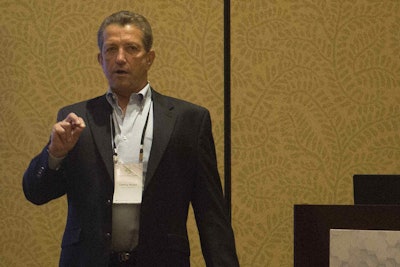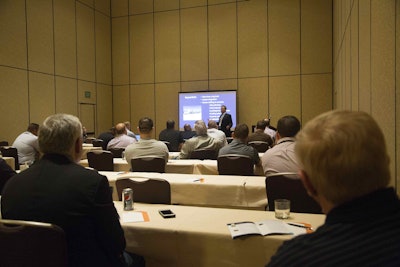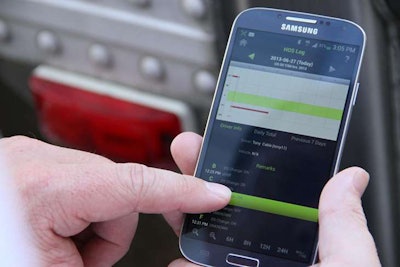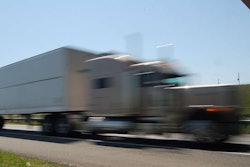At the CCJ Solutions Summit, Nov. 15, a fleet owner compared doing business in California to “watching your mother-in-law go over a cliff driving your new Cadillac.”
 Denny Wyatt, managing member and principal of Apex Logistics.
Denny Wyatt, managing member and principal of Apex Logistics.“It gives you mixed emotions,” said Denny Wyatt, managing member and principal of Apex Logistics, the largest dry bulk trucking company in California.
During a breakout session, Wyatt recommended fleets embrace technology, particularly electronic logging devices, to mitigate the risks from California labor laws.
“The ELD is more than a log book,” he said. “This is going to be the piece of the puzzle that is really going to make trucking work the best.”
California’s labor laws only apply to fleets with intrastate operations for now, but Wyatt said legislation tends to spread beyond the Golden State after three to four years.
“In the current political climate, we’ve probably been safer than we have been,” he said. “But we can’t count on that to last.”
One of the state’s laws requires that employers give one hour of paid time off (sick leave) to employees for every 30 hours of work. The employers can limit the accrual of sick leave to 24 hours or three days per year.
Apex notifies its drivers on paychecks for paid time off accruals, Wyatt said, but the law does not require drivers to give advance notice when they decide to use it.
“You could have a driver set up on a load in the middle of the day and the driver says ‘I’ll be gone for an hour. Take it off my personal time,’” Wyatt said. “Everything goes into disarray with dispatch.”
To complicate matters, the city of San Diego passed a law that eliminates the 24-hour maximum cap. When crossing city limits, “you are now in their jurisdiction,” he said. “They want the hour a driver spent in San Diego to be documented, and there is no max cap.”
California has 235 cities, he noted, and more jurisdictions could create similar laws that expand the maximum for paid time off.
“This could get really interesting, but the only way to comply is with ELDs and geo-fencing,” he said.

Wyatt said Apex Logistics has all the information it needs to comply with California labor laws using an ELD application from Omnitracs. The application tracks all driving and non-driving duties that include waiting for dispatch, fueling, paperwork, pre-and post-trip inspections, loading and unloading.
This record is important because the law requires companies to document every work-related activity to ensure that drivers are paid at least minimum wage for all of their time.
Fleets that use piece-rate pay models based on mileages, percentage-of-revenue, or flat rates for loads will continue to be targeted by lawyers that will contact their drivers in hopes of building class action lawsuits. A lawsuit might claim, for example, that drivers were not paid for doing post-trip inspections.
Among the trucking companies hit by class-action lawsuits for California labor laws are UPS ($87 million), Walmart ($100 million), Schneider Logistics ($21 million) and XPO Logistics ($855,000).
Wyatt, who has served as president of the California Trucking Association, says many of his peers have been hit with lawsuits ranging from $3 million and $5 million.
In addition to accounting for all work-related activities in driver pay, fleets must relieve drivers from all of their duties during required meal and rest breaks, or otherwise pay drivers for the time they worked. The state’s overtime laws are also complex, as the 10-hour breaks drivers normally would log as off-duty can be counted as overtime if drivers have to stay with their vehicle.
ELDs track the time that drivers use for meal and rest periods, Wyatt said.
“You need these records,” said Wyatt, and recommended fleets retain their logbook records for seven years. “You need to retain ELD data like payroll records.”

Apex has national accounts with most hotels and its drivers stay in hotels for overnight routes.
“Having a driver lay in a 36 or 40-inch sleeper for 10 hours is totally unacceptable,” he says. “In most cases we put a driver in a hotel and pay the bill.”
Most of its hotel rooms cost $40 a night. By eliminating the cost of idling and truck damage from parking at truck stops, having drivers stay in hotels is a cost savings, he said.
Using the information from ELDs has also improved efficiency and pricing by tracking loading and unloading times at customers and measuring fleet velocity.
For example, Apex Logistics runs 300 loads per day around the Los Angeles basin. Besides tracking driver activities, information captured by the ELDs showed that its equipment in the L.A. basin averages 35 mph. The company has priced shipments in this area accordingly, he said.
Wyatt encouraged attendees to support efforts by the American Trucking Associations to back the Denham Amendment, first brought to the table by Rep. Jeff Denham (R-Calif.) in 2015, to reassert federal authority over hours of service regulations and the industry’s standard per-mile driver pay model.












